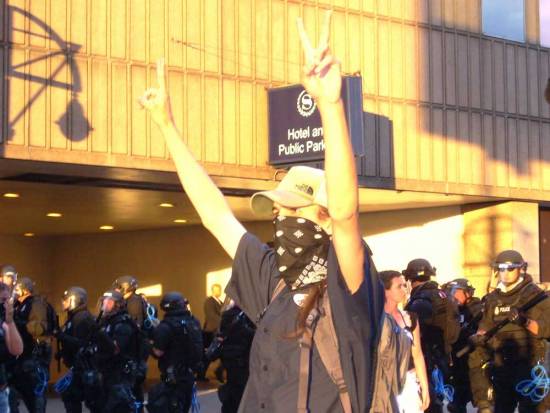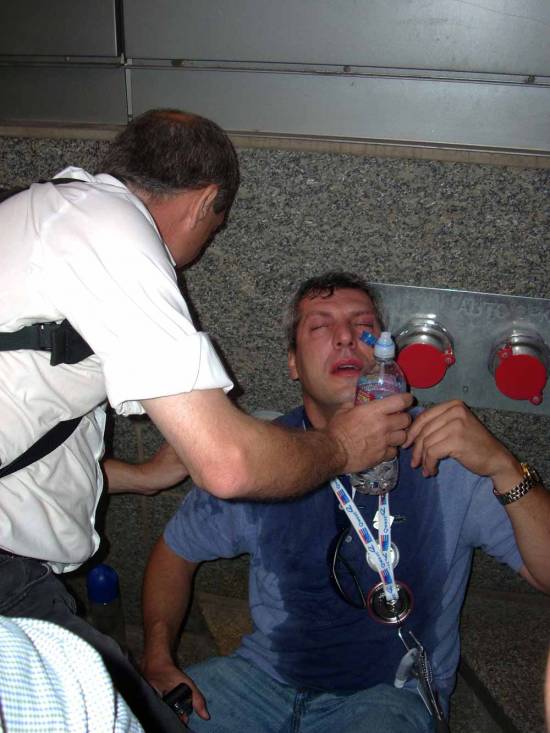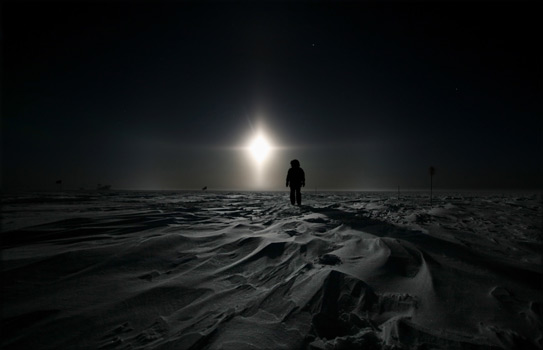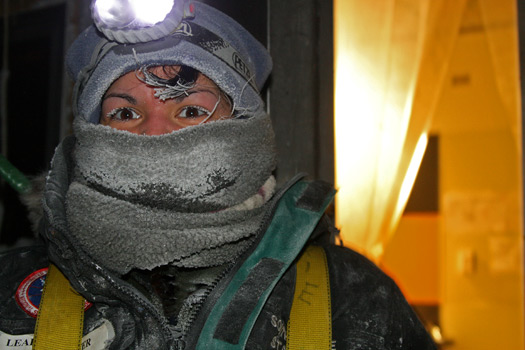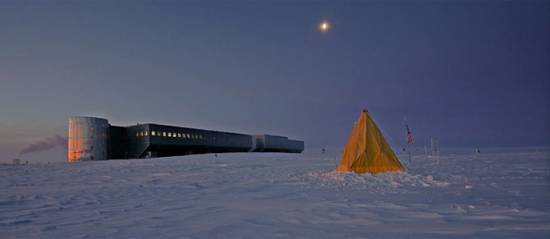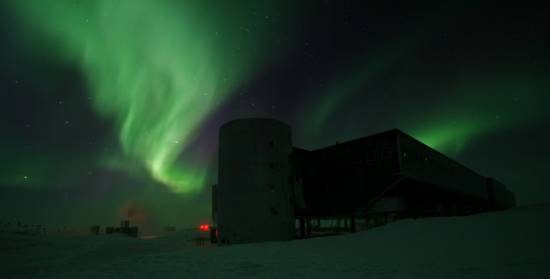My wife and I were driving home from a long Labor Day weekend spent in northern Minnesota. Traffic was light, considering there were more than 50,000 visitors in the Twin Cities for the Republican National Convention (RNC). At the other end of the Mississippi River, 1,200 miles to the south, Hurricane Gustav was slamming into New Orleans, the first hurricane to do so since Katrina in 2005. The country held its collective breath, waiting to see what damage the storm would bring, but in the streets of St. Paul, pepper spray hung in the air, riot police crushed protesters into the asphalt, and the National Guard stood watch.
We listened to reports of the chaos on the radio, hunched forward in our seats as our car zipped toward our apartment in St. Paul. By the time we collapsed into our beds that evening, exhausted from the long weekend, nearly 300 protesters were in jail. What began as a call for peace and a demonstration against the Republican Party ended in smashed windows, tear gas, and mass arrests. And this was only the first day.
Between Monday, Sept. 1 and Thursday, Sept. 4, the St. Paul Police Department and other cooperating agencies arrested 818 protesters. The vast majority of the protesters were nonviolent, but the police used pepper spray, tasers, rubber bullets, tear gas, and other “less lethal” crowd control measures. They conducted mass arrests, cordoning off streets and arresting everyone, including street medics, innocent bystanders, and journalists. Downtown St. Paul looked like a police state, filled with police officers in riot gear, an alphabet soup jumble of federal agents with three-letter acronyms, and National Guard soldiers.
Rick Kelley, of Coldsnap Legal Collective, a group of concerned citizens dedicated to providing support to activists involved in the legal system, was taken aback at the intensity of the police response. "I didn’t expect the preemptive raids, I didn’t expect the felonies, I didn’t expect the invocation of terrorism charges against people who are as far from terrorists as anyone I’ve ever met," Kelley said. "The kind of police response that we experienced was, I think, unprecedented in a lot of ways, and it shocked me."
Irene Greene, a practicing therapist and a coordinator with North Star Health Collective, felt the same way.
"It was a much wilder scene than any of us anticipated, but we were prepared for the worst, so folks were prepared for what they had to deal with: people getting beat by batons and beat up in jail, and tasers,” said Greene.
North Star Health Collective (NSHC) is a group of health care workers, students and community activists who are dedicated to access to health care for all, regardless of ability to pay. During the RNC, volunteers associated with NSHC organized, manned, and operated a first aid and wellness center in downtown St. Paul. The center housed a first aid station, a base of operations for the street medics who tended to injuries of both protesters and police, an outdoor decontamination center for people who’d been sprayed with chemical irritants, and a wellness center to help people cope with the mental trauma of protest-related violence.
First aid centers are common at large-scale protest events like the RNC, but the attention to the mental health needs of protesters was something new.
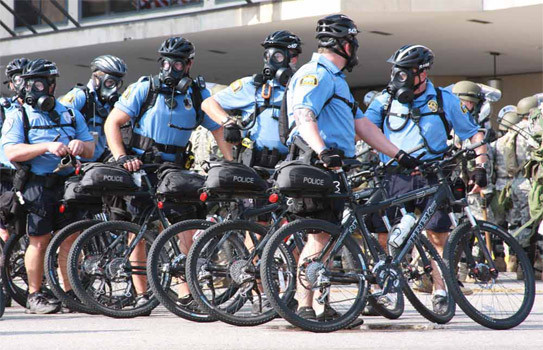
"One of the things that was especially unique about our center was that there hasn’t, to our knowledge, been a wellness and first aid center that has combined crisis counseling with the first aid/medic component," said Greene.
During the events surrounding the RNC, 58 street medics came from around the country and assisted more than 1,100 individuals with injuries as minor as blisters and sunburn and as severe as taser wounds and projectile injuries. There were 375 people decontaminated at the washing station outside the first aid and wellness center, 65 people treated at the first aid center, and another 85 counseled at the wellness center. There were 21 street medics who were arrested once, and four who were arrested twice, despite clear markings.
The volunteers and activists of Coldsnap Legal Collective (CLC) were also standing by to provide assistance to the protest groups. "Long days, little sleep, and a barrage of phone calls from people out on the street," said Becky, who asked that her last name be withheld, from CLC. Coldsnap encouraged protesters to write their legal hotline number on their arms or legs, so if they were arrested, the police couldn’t take it away. They fielded calls from protesters in the thick of the action, people who’d been arrested and were making their one phone call, and people who’d been released from jail. CLC served as a liaison between those in jail and their friends and family. They also maintained a vigil outside the Ramsey County Jail, so that arrestees would have warm food, clean clothes, and a hug when they were released.
The police were as prepared for the protests as the activists were. Infiltrators placed inside the protest groups kept the police informed on the protest actions planned during the week. On Friday, Aug. 29, the police launched a series of preemptory raids targeting activist groups and independent journalists when they entered the Convergence Space, a gathering place for anti-RNC activists. The next morning, there were three more raids in Minneapolis and another in St. Paul. The St. Paul raid targeted the base of operations of I-Witness Video, a NY-based group of photojournalists whose mission is to film and document police abuse. Video taken by I-Witness helped invalidate many of the charges filed in arrests surrounding the 2004 RNC in New York. Also targeted in the raids were the "RNC 8," prominent members of the RNC Welcoming Committee, an ironically named activist group. These eight people have been charged under the Patriot Act, and they face terrorism riot charges.
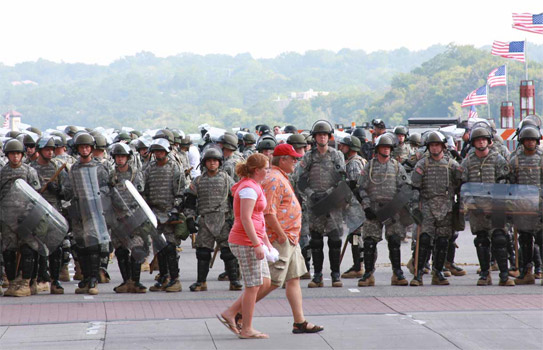
"Monday and Thursday were really big decontamination days," said Greene. On Monday, about 10,000 marchers from several different groups came to protest the war. The majority of protesters walked, chanted, and waved signs, but a few broke windows and blocked traffic. The police clamped down hard on the violence, arresting nearly 300, including journalists and street medics. They used tear gas, pepper spray, rubber bullets, and other "less than lethal" crowd-control measures, and eventually arrested almost 300 people, including passers-by caught up in the violence, and Amy Goodman, Nicole Salazar, and Sharif Abdel Kouddous from Democracy Now!
The protests and police violence culminated on Thursday in a drama played out over several hours on several highway overpasses near the state capital. A rally held at 4 p.m. fired up a crowd of about 2,000 for a march at 5 p.m., when the group’s legal permit to assemble expired. When the protesters headed for the Xcel Energy Center and the Republican delegates who were beginning to arrive, mounted police cut them off, blocking their path on the John Ireland bridge. As protesters moved east, to the Marion and Cedar Street bridges, the police moved as well, closing all downtown overpasses over the interstate and blocking the protesters’ path with snowplows, mounted police, and cops in riot gear, brandishing batons.
The standoff ended in the inevitable way. As the sun set and darkness settled in, the police issued the final order to disperse. Shortly thereafter, they moved in with tear gas, pepper spray, concussion grenades, and full riot gear. The police drove the group onto the Marion Street bridge and arrested everyone, including journalists and street medics.
"When I was out there on Thursday night, one of the first instances that happened is basically that this line of mounted police formed in front of some of my friends and I, and I stood there for several minutes, my friend and I stood there with our arms around each other and stood in front of them and just stood there,” said Becky. “All I wanted to do was have them look me in the eyes. And they wouldn’t do it. I actually said at one point, ‘Look me in the eyes, please look me in the eyes right now, and the woman looked down and gave this uncomfortable laugh […and said], ‘I can’t, I’m watching the crowd,’ and I thought, no, it’s because in the next minute if you’re ordered to beat the crap out of me, looking me in the eyes and recognizing me as a human being might prevent you from doing that. Making that human connection with me right now might prevent you from doing your job."
Becky, Greene and Kelley all agree that the purpose of the police actions seemed to be to demoralize protesters, to isolate them from their fellow activists and to discourage further protests, Instead of tearing activists apart, the harsh actions of the police had the opposite effect.
"I truly do not believe that anyone involved in the protester side of the convention is going to come out of that and say, ‘Well, clearly they’re right. Clearly I should no longer be anti-authoritarian,” said Becky. “Clearly, the government and the state and the police . . . know what’s up and I should probably listen to them from now on. You guys win.’ That’s not what we’re going to see, that’s not what we’re seeing. If nothing else, people are more politicized."
The response a lot of people have, in the example of Amy Goodman’s arrest, is, "She should have stopped when the cops told her to." When asked about Thursday’s events, many people respond, "Oh, well, their permit expired at 5 p.m. They shouldn’t have been there." Both of these arguments boil down to "You should do what you’re told." And that’s true, at least if you want to stay out of jail. I knew at 5:30, when the standoff on the bridges over I-94 was just beginning, that there were going to be arrests and tear gas and everything else. Every person on that bridge, be they protester, police, journalist or observer, must have known it too. After the events earlier in the week, how could they not?
The problem comes in when what you’re being told to do is unjust. Then you have two choices: go home and allow the injustice to continue or refuse to do what you’re told, make your voice heard, and suffer the consequences. When the state is unjust, you can’t wait for the state to give you permission to object to their actions. During the civil rights movement, marchers were refused permits and faced fire hoses and police dogs. They marched anyway, because they knew what they stood for was honorable and just. This is why people stayed in the streets of St. Paul, knowing what was about to happen to them and standing defiant. They had something to say and were determined to be heard.
In situations like these, I try to think about things from the opposing view. What was going through the minds of the police involved? I assume, from the cops I’ve met and known, that most of the police involved were good people doing the best they could in a tough but necessary job.
“I don’t think you can police always for the best in the crowd. You have to police for the worst in the crowd,” said Ramsey County Sheriff Bob Fletcher in an interview with Amy Goodman. It wasn’t an easy situation, either. Downtown St. Paul was filled with celebrities from around the country. The national spotlight was fixed on our city. We wanted to make a good impression.
Also assumed: the police are a tool of the state. They are the monopoly on violence that any government must maintain, without which it cannot exist. I buy into government’s basic assumption: violence is inevitable. We are all humans. We are violent creatures. Someone will always be in charge. But I also buy into the basic assumption of anarchy: I am my own best boss. If we all treat each other like adults, we don’t need the enormous infrastructure of government and we can all get along. It’s an optimistic viewpoint, and I buy it. At least until someone gets shot.
So what happened? Why did the police turn on the citizens of the Twin Cities and our guests with such brutal force? Why did they spend so much time infiltrating activist groups? Why did they use pepper spray, tear gas, and concussion grenades against nonviolent protesters? Did it have anything to do with the $10 million lawsuit insurance policy the city of St. Paul negotiated with the Republican National Convention?
"If you’re going into something knowing that you’re not going to be held accountable in your community… and you’re not going to have to deal with that public pressure, I think it lifts a little bit of that weight off your shoulders and gives you a little be more free reign,” said Becky.
The agreement, made between the RNC and the city of St. Paul, is unprecedented, and covered "up to $10 million in damages and unlimited legal costs for law enforcement officials accused of brutality, violating civil rights and other misconduct," according to the Minneapolis Star Tribune, in an article published Sept. 3, 2008. An agreement like this creates a situation where the police don’t have to worry about the legality of their actions, because they know there won’t be any heat from taxpayers. Instead, maintaining "order" becomes the prime directive, and constitutional rights are violated in the interest of temporary security.
It’s easy, though, to get bogged down in the negativity that surrounded the RNC. Rudy Giuliani and Sarah Palin may have mocked community organizers in their speeches to the Republican delegates, but on the streets of St. Paul, friendships were being forged in the crucible of a shared crisis. Communities were organized. "I feel like I met people that I will be friends with for life," said Greene. "To go through something like that, it’s definitely a uniting experience."
Giuliani, Palin and others may sneer at people who care enough to go out into their community, reach out and try to make their community a better place, but it hasn’t stopped those who were brought together by events surrounding the RNC. One of the shared goals of the many activist groups that protested at the RNC in 2008 was to build solidarity and bring together like-minded people. In that sense, the protests were a success.
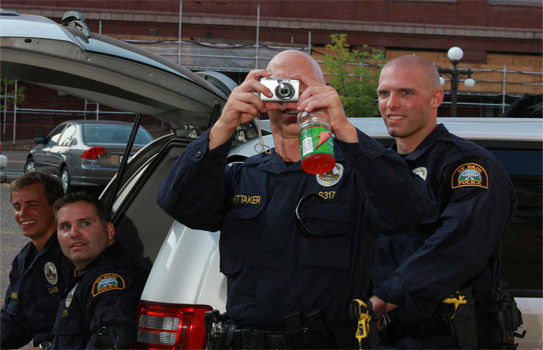
Epilogue
Becky, Coldsnap Legal Collective:
"One of the most beautiful things I saw out of this week was how close we became as a community. The number of hugs that I got, the length of time of those hugs. We held each other longer, we cried together. People that I didn’t know that well before the event, I could meet them on the street and be like, ‘I remember talking to you when you were in jail, I’m really glad you’re out. Can I give you a hug? How are you doing? Thank you for being out on the street,’ and they would respond with ‘Thank you for being in the office.’ That kind of mutual support and mutual aid and caring was really great.
"The state uses this divide and conquer technique. We saw that on a smaller scale in the convention, even in just little things, like isolating individuals, putting them in solitary, or dropping them off in the middle of nowhere after they got out of jail, It’s trying to isolate people, trying to make people feel like they’re alone, feel like they don’t have any people to support them. Those isolation tactics can be very useful if we don’t recognize that together, we’re really strong and we have each other’s backs. If we allow members of our community, whether radical or not, to be isolated and to be picked off, it makes the larger group smaller. They just keep picking us off one by one.
"We have amazing community resources in our city right now. We have a legal collective where none existed before. We have a radical healthcare collective. We have a community bike space. We have a group that formed around confronting and dealing with sexual assault in society… there are things to be optimistic about."
Aaron Richner I am a writer/editor turned web developer. I've served as both Editor-in-chief and Technical Developer of In The Fray Magazine over the past 5 years. I am gainfully employed, writing, editing and developing on the web for a small private college in Duluth, MN. I enjoy both silence and heavy metal, John Milton and Stephen King, sunrise and sunset. Like all of us, I contain multitudes.
- Follow us on Twitter: @inthefray
- Comment on stories or like us on Facebook
- Subscribe to our free email newsletter
- Send us your writing, photography, or artwork
- Republish our Creative Commons-licensed content


